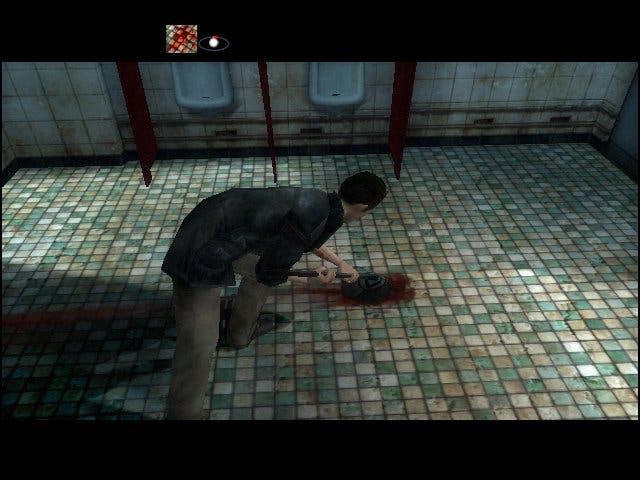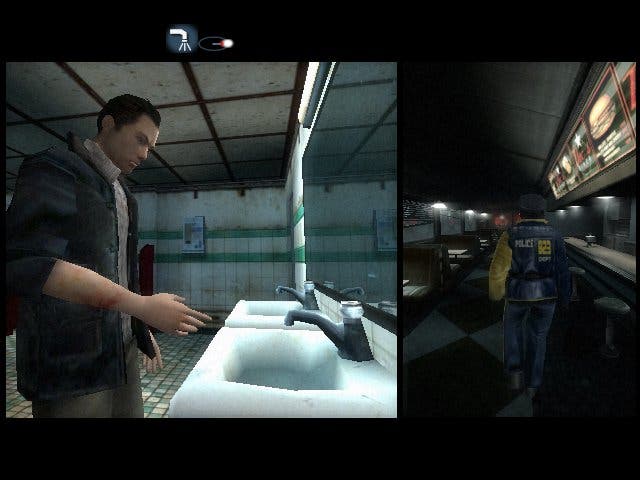Fahrenheit
We're getting hot under the collar about it.
You know how it is. You've just attempted to eat a dodgy Steak and Eggs in your local diner. It seemed like a good idea at the time, but the upshot is that you're sitting in a rarely cleaned cubicle out back surveying the graffiti and wishing you'd lain toilet tissue around the seat before you sat down on it. The floor's slick with carelessly dispensed urine, half the lights don't work, the barred window's open and it's snowing outside. And then an innocent regular enters to remove the cheap coffee from his system and you try to put your senses on standby for a few more seconds before making your exit. An everyday, unremarkable scene of urban squalor the world over.
What do you do next? Continue to scan for 'witty' asides daubed at jaunty angles along the flaking paintwork and wait for the anonymous customer to take his tuneless whistling elsewhere, or whip out the steak knife you took with you and stagger towards the unsuspecting, bespectacled, balding middle-aged man and plunge it three times into his chest? Did he really deserve to die for practising his Crazy Frog impersonation in the lav? Too late now. The guy's dead quicker than it took him to have a leak. 47 years: gone, and the blood's spreading out across the cold rusty tiles.
Temperature rising
And that's where Fahrenheit kicks off; with blood on your hands, a dead body to decide what to do with and an escape plan to hatch. It's a murder mystery adventure with a difference. Not only do you play the bewildered killer, Lucas Kane, but also as the crime scene investigators Carla and Tyler in a game that as much about making choices as it is finding the solution.
The four-chapter playable demo delivered this week offered an exciting glimpse of what to expect from Quantic Dream' latest effort, and instantly marks itself out as a very interesting evolution of the adventure genre that takes a bold and fresh approach that delivers an intriguing degree of choice.
Choice is everywhere in Fahrenheit, right from the word go. Do you leave the body where it is and run out of the diner as quickly as possible, or do you drag it into the cubicle (curiously using a shoulder button mashing technique borrowed from '80s sports classic Track & Field), mop the floor and wash your hands to buy yourself some time? Whatever you do you'll need to get out of there fast, but do you sit down first and pay your bill and act casual before the cop sitting behind you goes and takes a leak himself? Decisions decisions.
Watching the detectives

Soon enough the action switches to Carla and Tyler, called to the scene upon the grim discovery of the body. Suddenly the emphasis is turned on its head: to try and establish the identity of the mystery killer, questioning the shell-shocked waitress, the drunken hobo in the alley outside, and leaving no stone unturned in finding clues. For example, whose blood is in the adjacent cubicle to the corpse? What's the significance of the discarded Tempest book at Lucas' table? Why did the killer leave the deceased's wallet behind? Of course, you could miss a vital clue, be slapdash in your examinations or fail to quiz a witness in the most effective manner, and all of these choices have a subtle bearing on how things pan out. How subtle, it was hard to tell at this early stage, but, for example, if I hadn't decided to make Lucas sit down upon his exit, there wouldn't have been any blood for Carla to notice.
After you've concluded your investigation the action moves onto the next morning, where Lucas realises the whole thing is much more than a dream. His sheets are bloodied and a cop is on his way to his apartment to follow up complaints from the neighbours who overheard screaming during the night. In another time-sensitive episode you must quickly get dressed and hide the evidence so as to not raise the alarm. The action is tense and full of trial-and-error as you jog around looking for clues and end up getting busted for your procrastination and lack of attention to detail.
But it's fun, involving, and atmospheric - and unlike most adventures you'll have played. It twists the narrative to reflect the choices you've made, and that's something of which I'd like to see more. This lends a potential replayability all-too-lacking in most narrative/puzzle-driven games; normally it's a case of finding an object, putting a broken mechanism back together, unlocking a door and moving on, but Fahrenheit has so many shades of grey in terms of what you do and don't do, it offers a truly intriguing experience.
For example, in the concluding chapter in the demo, the first real major choice has to be made. Having confessed your crime to your shocked brother in a nearby park, you notice a young boy is about to slip into the icy lake and drown. You could dive in after him, haul him about and deliver a heart massage, but you risk being seen by the same Police Officer that saw you in the diner the night before. Surely you'll be caught and arrested? Maybe the best thing is to ignore the boy's plight, walk the other way and let someone else play the hero. After all, you want to stay free, right? All these small decisions promise to have a distinct bearing on how characters react to you in the future, and it'll be very interesting to see just how much they change the course of the plot.
Multiple choice

In terms of interface, the third-person controls are somewhat unique, but flexible and intuitive. At the beginning, the CEO of Quantic Dream, David Cage, gives his own slick mini-tutorial, talking through how to use the camera and the simple interface. In adventure terms, there's really nothing like it, with the right stick utilised for selecting context sensitive icons that appear at the top of the screen as and when appropriate during conversations or when you walk past potentially useful points of interest. For example, opening a door might involve pushing the stick up, while drinking a cup of coffee might demand you mimic the actual hand action of picking up the cup and bringing it to your mouth - in this instance a semi-circular arc. Initially it can seem a bit fiddly and given multiple choices it's often easy to select the wrong one, but that's more down to the system's unfamiliarity that anything.
Movement is controlled with the left stick, while the camera generally does a good job of giving you a decent automatic view of what's going on, although you can wrestle control back with the left and right shoulder buttons, or the black button to give you a first-person view. Arguably it could have done with standard two-stick third-person controls, but it's not a major issue.
Visually the game has a pleasant gritty look to it - part Silent Hill, but with a style of its own. Packed with excellent character detail, superior flowing animation and atmospheric locations, it's evidently a game that Quantic Dream has really slaved over.
Even the audio has been given the necessary attention to detail, featuring solid, well acted voiceovers that give the game an almost Film Noir ambience, with Angelo Badalamenti (Twin Peaks, Booth And The Bad Angel) brought on board to lend the game's soundtrack the kind of brooding intensity that a game like this is crying out for. Good choice. Unusually for an adventure game a bunch of licensed tracks have made the cut, with the player able to cycle through several known tracks on your home stereo, as well as put on the juke box in the diner. All round, it's a game that's evidently benefited from Atari's extra investment after the game was apparently cut adrift by its original publisher Vivendi-Universal. Good news.
Bad Angel
After the promise shown at E3 2004 I was always intrigued by what Fahrenheit had to offer (known, strangely, as Indigo Prophecy outside of Europe), but now I've finally had a chance to play a chunk of it I'm confident that adventure fans will be overjoyed that forward thinking games like this can still be released in this play-safe era.
Quantic Dream's Fahrenheit will be published by Atari on PC, Xbox and PS2 and is scheduled for a September 5th release across Europe.




